Regular taxis
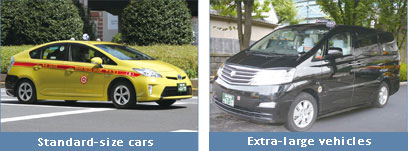 In Tokyo there are a total of 50,000 taxis being operated, including by companies and individuals, and they include standard-size cars, large vehicles and extra-large vehicles.
In Tokyo there are a total of 50,000 taxis being operated, including by companies and individuals, and they include standard-size cars, large vehicles and extra-large vehicles.
Special-needs and universal design (UD) taxis
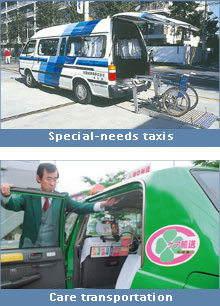 Special-needs taxis include special-purpose vehicles patients can board while in a wheelchair or a bed, and general cars also operate as special-needs taxis under contracts with local governments and can be used by anyone. We also offer a "care transportation service" for disabled persons and the elderly who need help when going out.
Special-needs taxis include special-purpose vehicles patients can board while in a wheelchair or a bed, and general cars also operate as special-needs taxis under contracts with local governments and can be used by anyone. We also offer a "care transportation service" for disabled persons and the elderly who need help when going out.
And for the future accessible society, there is a new type of taxi, the universal design (UD) taxi. Their biggest advantage is a standard-equipment ramp that allows people in wheelchairs to get in and out. They feature innovations that allow customers with back and mobility problems to easily get in and out, and they can hold a lot of baggage. As of March 31, 2013, there are 28 of these taxis in operation. For the drivers of these vehicles, to improve the experience of these customers, educational training is already being carried out by the Tonai Musen Cooperative and various taxi companies, and beginning in December of 2012, the Tokyo Hire-Taxi Association began providing "universal driver training". One hundred and three drivers are attending as of April 2013.
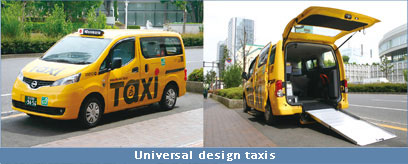
Sightseeing taxis
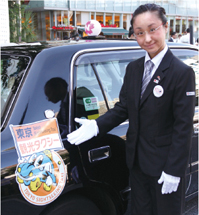 These taxis allow customers to enjoy Tokyo sightseeing freely with family or friends, or as a couple, with a small number of people, and so have an experience unavailable with a bus tour or group travel. A driver arranges sightseeing locations to match the wishes and schedules of customers, then escorts them and provides information. Since July 2012, the Tokyo Hire-Taxi Association has been carrying out "Tokyo Sightseeing Taxi Driver Certification Training", which covers the basic services and knowledge necessary for a sightseeing taxi driver, and as of April 2013, 468 drivers are attending.
These taxis allow customers to enjoy Tokyo sightseeing freely with family or friends, or as a couple, with a small number of people, and so have an experience unavailable with a bus tour or group travel. A driver arranges sightseeing locations to match the wishes and schedules of customers, then escorts them and provides information. Since July 2012, the Tokyo Hire-Taxi Association has been carrying out "Tokyo Sightseeing Taxi Driver Certification Training", which covers the basic services and knowledge necessary for a sightseeing taxi driver, and as of April 2013, 468 drivers are attending.
Radio taxis
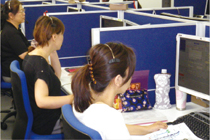 In Tokyo at present there are approximately 23,000 taxis for hire that can be ordered using a telephone, operating out of 115 base stations. In recent years, as the transition from analog to digital radio has advanced, the wait time to dispatch a car has been greatly reduced.
In Tokyo at present there are approximately 23,000 taxis for hire that can be ordered using a telephone, operating out of 115 base stations. In recent years, as the transition from analog to digital radio has advanced, the wait time to dispatch a car has been greatly reduced.
Ordering a taxi with a smart phone
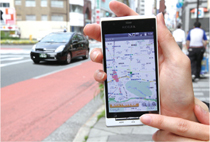 With the increase in the number of smart phones in recent years, it has become possible to use an application to quickly and easily order a taxi. Because these applications feature many functions and eliminate the need to tell a driver your address or destination, their use is growing.
With the increase in the number of smart phones in recent years, it has become possible to use an application to quickly and easily order a taxi. Because these applications feature many functions and eliminate the need to tell a driver your address or destination, their use is growing.
| Year |
2000 |
2001 |
2002 |
2003 |
2004 |
2005 |
2006 |
| No. of radio taxis |
32,781 |
33,138 |
33,487 |
33,799 |
32,942 |
31,363 |
32,408 |
No. of above
that are
dispatched using digital radio |
|
|
|
1,861 |
8,089 |
14,028 |
18,486 |
| Year |
2007 |
2008 |
2009 |
2010 |
2011 |
2012 |
|
| No. of radio taxis |
33,308 |
30,882 |
30,357 |
26,720 |
22,488 |
22,392 |
|
No. of above
that are
dispatched using digital radio |
23,598 |
24,515 |
24,467 |
23,992 |
21,675 |
21,827 |
|
Radio taxi contact list
Hired cars
 Hired cars play one part in public transportation in the capital, Tokyo. Responding to various needs not fulfilled by taxis, they offer a menu of transport options including large-sized cars, medium-sized cars and sedans, fulfilling an important role 24 hours a day. As of March 2013, there are 3,361 hired cars at various places of business, and they are dispatched in a timely and appropriate manner in response to requests. To improve service further, we are working to thoroughly educate drivers, and we are also operating cars that can carry beds to meet special needs such as transport between hospitals.
Hired cars play one part in public transportation in the capital, Tokyo. Responding to various needs not fulfilled by taxis, they offer a menu of transport options including large-sized cars, medium-sized cars and sedans, fulfilling an important role 24 hours a day. As of March 2013, there are 3,361 hired cars at various places of business, and they are dispatched in a timely and appropriate manner in response to requests. To improve service further, we are working to thoroughly educate drivers, and we are also operating cars that can carry beds to meet special needs such as transport between hospitals.
![Tokyo Taxi [Tokyo Hire-Taxi Association(THTA)]](/english/assets/images/common/logo.png)
 In Tokyo there are a total of 50,000 taxis being operated, including by companies and individuals, and they include standard-size cars, large vehicles and extra-large vehicles.
In Tokyo there are a total of 50,000 taxis being operated, including by companies and individuals, and they include standard-size cars, large vehicles and extra-large vehicles. Special-needs taxis include special-purpose vehicles patients can board while in a wheelchair or a bed, and general cars also operate as special-needs taxis under contracts with local governments and can be used by anyone. We also offer a "care transportation service" for disabled persons and the elderly who need help when going out.
Special-needs taxis include special-purpose vehicles patients can board while in a wheelchair or a bed, and general cars also operate as special-needs taxis under contracts with local governments and can be used by anyone. We also offer a "care transportation service" for disabled persons and the elderly who need help when going out.
 These taxis allow customers to enjoy Tokyo sightseeing freely with family or friends, or as a couple, with a small number of people, and so have an experience unavailable with a bus tour or group travel. A driver arranges sightseeing locations to match the wishes and schedules of customers, then escorts them and provides information. Since July 2012, the Tokyo Hire-Taxi Association has been carrying out "Tokyo Sightseeing Taxi Driver Certification Training", which covers the basic services and knowledge necessary for a sightseeing taxi driver, and as of April 2013, 468 drivers are attending.
These taxis allow customers to enjoy Tokyo sightseeing freely with family or friends, or as a couple, with a small number of people, and so have an experience unavailable with a bus tour or group travel. A driver arranges sightseeing locations to match the wishes and schedules of customers, then escorts them and provides information. Since July 2012, the Tokyo Hire-Taxi Association has been carrying out "Tokyo Sightseeing Taxi Driver Certification Training", which covers the basic services and knowledge necessary for a sightseeing taxi driver, and as of April 2013, 468 drivers are attending. In Tokyo at present there are approximately 23,000 taxis for hire that can be ordered using a telephone, operating out of 115 base stations. In recent years, as the transition from analog to digital radio has advanced, the wait time to dispatch a car has been greatly reduced.
In Tokyo at present there are approximately 23,000 taxis for hire that can be ordered using a telephone, operating out of 115 base stations. In recent years, as the transition from analog to digital radio has advanced, the wait time to dispatch a car has been greatly reduced. With the increase in the number of smart phones in recent years, it has become possible to use an application to quickly and easily order a taxi. Because these applications feature many functions and eliminate the need to tell a driver your address or destination, their use is growing.
With the increase in the number of smart phones in recent years, it has become possible to use an application to quickly and easily order a taxi. Because these applications feature many functions and eliminate the need to tell a driver your address or destination, their use is growing. Hired cars play one part in public transportation in the capital, Tokyo. Responding to various needs not fulfilled by taxis, they offer a menu of transport options including large-sized cars, medium-sized cars and sedans, fulfilling an important role 24 hours a day. As of March 2013, there are 3,361 hired cars at various places of business, and they are dispatched in a timely and appropriate manner in response to requests. To improve service further, we are working to thoroughly educate drivers, and we are also operating cars that can carry beds to meet special needs such as transport between hospitals.
Hired cars play one part in public transportation in the capital, Tokyo. Responding to various needs not fulfilled by taxis, they offer a menu of transport options including large-sized cars, medium-sized cars and sedans, fulfilling an important role 24 hours a day. As of March 2013, there are 3,361 hired cars at various places of business, and they are dispatched in a timely and appropriate manner in response to requests. To improve service further, we are working to thoroughly educate drivers, and we are also operating cars that can carry beds to meet special needs such as transport between hospitals.